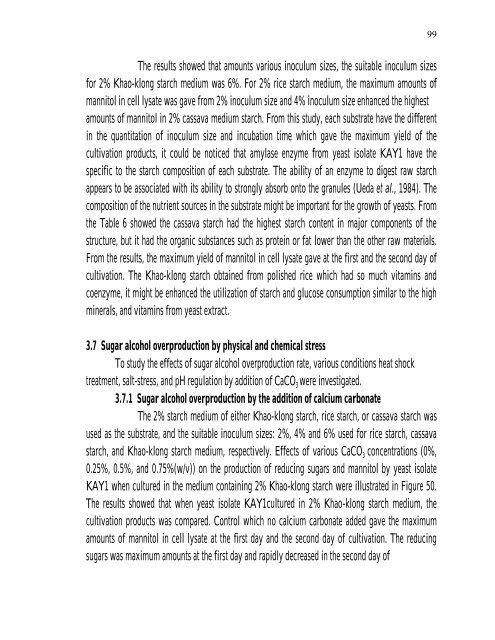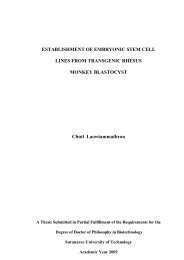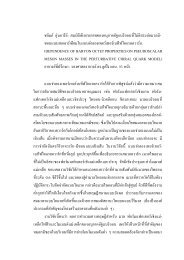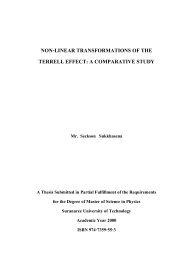PRODUCTION Of NUTRIENT SOURCES FOR RHIZOBIUM
PRODUCTION Of NUTRIENT SOURCES FOR RHIZOBIUM
PRODUCTION Of NUTRIENT SOURCES FOR RHIZOBIUM
Create successful ePaper yourself
Turn your PDF publications into a flip-book with our unique Google optimized e-Paper software.
The results showed that amounts various inoculum sizes, the suitable inoculum sizes<br />
for 2% Khao-klong starch medium was 6%. For 2% rice starch medium, the maximum amounts of<br />
mannitol in cell lysate was gave from 2% inoculum size and 4% inoculum size enhanced the highest<br />
amounts of mannitol in 2% cassava medium starch. From this study, each substrate have the different<br />
in the quantitation of inoculum size and incubation time which gave the maximum yield of the<br />
cultivation products, it could be noticed that amylase enzyme from yeast isolate KAY1 have the<br />
specific to the starch composition of each substrate. The ability of an enzyme to digest raw starch<br />
appears to be associated with its ability to strongly absorb onto the granules (Ueda et al., 1984). The<br />
composition of the nutrient sources in the substrate might be important for the growth of yeasts. From<br />
the Table 6 showed the cassava starch had the highest starch content in major components of the<br />
structure, but it had the organic substances such as protein or fat lower than the other raw materials.<br />
From the results, the maximum yield of mannitol in cell lysate gave at the first and the second day of<br />
cultivation. The Khao-klong starch obtained from polished rice which had so much vitamins and<br />
coenzyme, it might be enhanced the utilization of starch and glucose consumption similar to the high<br />
minerals, and vitamins from yeast extract.<br />
3.7 Sugar alcohol overproduction by physical and chemical stress<br />
To study the effects of sugar alcohol overproduction rate, various conditions heat shock<br />
treatment, salt-stress, and pH regulation by addition of CaCO 3 were investigated.<br />
3.7.1 Sugar alcohol overproduction by the addition of calcium carbonate<br />
The 2% starch medium of either Khao-klong starch, rice starch, or cassava starch was<br />
used as the substrate, and the suitable inoculum sizes: 2%, 4% and 6% used for rice starch, cassava<br />
starch, and Khao-klong starch medium, respectively. Effects of various CaCO 3 concentrations (0%,<br />
0.25%, 0.5%, and 0.75%(w/v)) on the production of reducing sugars and mannitol by yeast isolate<br />
KAY1 when cultured in the medium containing 2% Khao-klong starch were illustrated in Figure 50.<br />
The results showed that when yeast isolate KAY1cultured in 2% Khao-klong starch medium, the<br />
cultivation products was compared. Control which no calcium carbonate added gave the maximum<br />
amounts of mannitol in cell lysate at the first day and the second day of cultivation. The reducing<br />
sugars was maximum amounts at the first day and rapidly decreased in the second day of<br />
��






